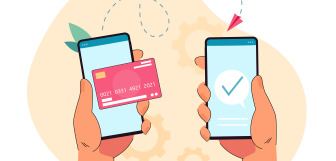Mobile Payments: How They Increase Your Business Efficiency
As a retail or hospitality business owner, you're always looking for ways to increase efficiency and reduce costs. Accepting mobile payments is a great way to do both.
The world's going cashless fast. According to Statistica, apps like Apple Pay and Google Wallet are set to double in use in the States by 2025. And, if you strive to meet your customers where they are, then offering them the convenience of multiple payment options is key.
Mobile payment processing is pretty simple for merchants like yourself to offer. However, it does require a bit of effort upfront. Simple things like investing in point of sale (POS) software and hardware that can handle contactless payments.
So, we're giving you a complete guide on all things mobile payments, from what they are and how they work to how to accept mobile payments at your business.
Let's get started!
What are mobile payments?
Mobile payments are digital transactions that use smartphones (like your iPhone or Samsung) to pay for products or services, offering a quick and easy payment option.
By using secure mobile payment apps or technologies like Apple Pay, Google Pay, Samsung Pay, or another mobile wallet, your customers just have to tap or scan their device at a payment terminal to make a payment.
This modern payment method is gaining popularity. In fact, global mobile pay volume is predicted to reach $6 trillion this year.
What are the types of mobile payments?
Now that you know what they are, let's go over some of the different types of mobile payment technology you'll find out there:
Mobile wallets
A mobile wallet is basically a digital wallet that's on your phone. When you go into your mobile wallet app, you'll be able to add and store your credit card or debit card details (a lot of mobile wallet apps let you add multiple cards). So, instead of using your actual card to make payments, you can just pay on your mobile device.
The technology that's used to make mobile wallet payments happen is called near field communication, or NFC for short. It essentially connects two devices—like your phone and a card machine— helping them communicate wirelessly when they’re close together (which is where the "near" comes from in near field communication).
If you want to accept mobile wallet payments at your business, you'll need a POS that’s equipped with the technology that can process these types of transaction such as the Epos Now Complete Solution.
Mobile ecommerce
This type of mobile payment, which you might also have heard been referred to as m-commerce, is when you buy and sell your best goods and services through a wireless handheld device, like a smartphone or tablet. It's essentially a form of e-commerce that lets its users access online shopping platforms without the need for a desktop computer or laptop.
If one of your customers makes online transactions on their phone's browser or on your company's proprietary app, that counts as a mobile ecommerce payment. Mobile payments on ecommerce stores can be made using a mobile wallet, credit card, or an accelerated checkout platform like Shop Pay.
Mobile payment apps
These are dedicated apps that allow users to transfer money or make payments directly from their mobile devices. You'll likely have heard of the big names out there, like Venmo, PayPal, and Cash App.
How it works is that these apps often link to bank accounts or credit/debit cards, allowing users to send money to friends, family, or businesses with just a few taps on their screens.
Payments by SMS
SMS-based payments involve sending and receiving money through text messages.
This payment method is particularly useful in regions where smartphones aren't used as much or have lower penetration, as it allows users to conduct transactions using basic mobile phones. Typically, users link their bank account or mobile wallets to their mobile phone numbers, and transactions are authenticated via SMS.
Mobile payment systems
Mobile Point of Sale (mPOS) systems are completely changing how businesses handle transactions on the go. They're allowing merchants to accept payments anywhere, anytime, using a smartphone or tablet equipped with a card reader and specialized software.
TIP
Our product, the Pro+, takes mobile payment systems to the next level. It combines the convenience of a portable card machine with the powerful capabilities of award-winning Epos Now software. This all-in-one solution empowers businesses to manage sales, inventory, and customer relationships efficiently, all from a single device.
What are the disadvantages and advantages of mobile payments?
Let's now jump into the pros and cons of mobile payments. They've definitely made transactions more convenient, but like anything, there are trade-offs to consider.
Benefits of mobile payment for business efficiency
- Mobile contactless payments are super quick—like, just about a second quick. They're faster than swiping a card and way speedier than those chip payments that can feel like they take forever. For businesses with checkout lines, like quick-service restaurants and retailers, contactless payments can really speed things up. That means shorter lines and more sales in less time.
- They're incredibly convenient because these days, people are carrying less cash and more phones. With mobile payments, you can skip the ATM and just send money through your bank's app. No more digging around for your wallet at the checkout—you can just tap your phone, and you're done.
- They're seriously secure. Mobile payments use fancy encryption tech that keeps your info safe. They're way safer than old-school magstripe cards and just as secure as those chip cards everyone uses. Some apps even use face ID for extra security making them arguably safer than using a chip card.
Disadvantages of mobile payment methods
Here are a few downsides to mobile payments:
- They can be dependent on technology. If your customer's phone runs out of battery or you lose it, you might not be able to pay.
- Not all businesses accept mobile payments yet. So, you might still need to carry cash or cards as a backup.
- Some people worry about security. Even though mobile payments have strong encryption, there's always a risk of cyber threats or unauthorized access.
How does mobile payment processing work?
Here's how mobile payment processing for mobile works: When you're ready to pay at a store, bring your mobile device close to the NFC-enabled payments terminal, usually within about 2 inches. This proximity sets the transaction in motion without any physical contact, which is why mobile wallet payments are often called contactless payments.
During a mobile wallet transaction, your device and the NFC-enabled point of sale communicate using a specific radio frequency. They exchange encrypted information to process the payment quickly—usually in just seconds. This speed is a major advantage over magstripe and chip card transactions, not to mention cash.
Security is another key feature of mobile payments, thanks to something called tokenization. This technology protects your bank details within mobile payment apps. Take Apple Pay, for example: When you add your credit card to your iPhone, Apple sends the card details to your bank or network. They then replace those details with a unique set of randomly generated numbers (the token), which Apple programs into your phone. This means that even if someone were to intercept the transaction data, they wouldn't have your actual bank information, enhancing security against fraud.
TIP
Want to learn more about payment processing? Check out our in-depth guide on how payment processing works.
How to accept mobile payments with Epos Now
Accepting payments with Epos Now is super straightforward and can be a massive benefit to your business. Here’s how we make it easy:
- Seamless integration: Our payment processing service smoothly integrates with your retail or hospitality point of sale system, making it hassle-free for you.
- Single management: Manage all your payment needs from one place, handled by a single provider, reducing complexity and saving time.
- Versatile payment options: Accept chip and pin, contactless payments, and remote payments via link, catering to diverse customer preferences and needs.
- Fast and secure transactions: Process payments quickly and securely, ensuring smooth transactions that meet PCI compliance standards for data security.
- Transparent pricing: Enjoy clear, upfront pricing with no hidden fees or surprises, helping you budget effectively.
- Detailed reporting: Access detailed payment reports instantly to track transactions and gain insights into your business performance effortlessly.
- 24/7 support: Our dedicated support team is available round-the-clock, ready to assist with any payment-related questions or issues you may have.
Epos Now Payments is designed to enhance your payment processing experience, ensuring reliability, security, and ease of use for your business operations.
FAQ about mobile payments
- What is a mobile payment example?
-
A mobile payment example is using apps like Apple Pay or Google Pay on your smartphone to pay for things instead of cash or cards. You just tap your phone near the payment terminal to complete the transaction.
- What is the future of mobile payments?
-
The future of mobile payments looks bright. More people are using smartphones, and businesses are making it easier to pay with them. We might see more ways to pay, like using wearables or even biometrics (like your fingerprint) for payments.
- What is needed for mobile payments?
-
To use mobile payments, you typically need a smartphone or tablet with a mobile payment app installed, like Apple Pay or a bank’s app. Businesses also need a compatible payment terminal that supports NFC (near field communication) technology.
- Why do people use mobile payments?
-
People use mobile payments because they’re fast and convenient. You don’t need to carry cash or cards—just your phone. It’s also secure, with encryption to protect your payment information. Plus, mobile payments are becoming more common, accepted at more stores and for more types of purchases.




